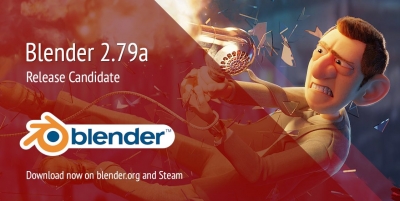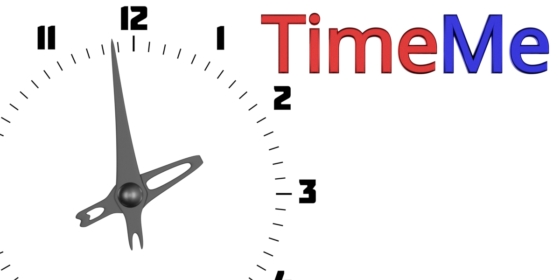Blender 3D
How to hide the title of the Blender window
Every 3D-artist knows that the workplace is always less. The larger monitor, the larger available workspace on it – the work is more convenient and faster. Blender allows winning some extra space on the screen, hiding the window title, which is still not useful.
The key combination:
alt + F11
allows to hide the Blender window title and expand the work area to the entire monitor. Pressing this key combination again returns Blender to its original state.
2.79a Release Candidate
Blender 2.79a Release Candidate is available for download on the Blender official site.
The current release contains over 200 bugfixes.

Add-on TimeMe v.1.1.0
Blender add-on TimeMe v.1.1.0 update.
- Seconds accuracy enabled
- Added Copy to clipboard function
- Added Reset time function
How to render in Blender without slowing down the other programs
During the image rendering in Blender, it is impossible to do anything else, the computer is strong “brakes”. Blender takes all available computing power without leaving almost nothing to other applications.
In order to run render in Blender with a low priority, so that it does not fill the entire computer and is guaranteed not to slow down the other programs work, you need:
- Switch the render mode to the CPU
- Run the render in Blender from the command line:
Windows:
|
1 |
start "" /LOW /MIN /B /D "_path_to_blender_directory_" "_full_path_to_blender_" -b _path_to_blend_file_ -f X -t X1 |
parameters used :
- /LOW – means that Blender will be launched with the lowest priority, computing power will be allocated to it after the all other programs.
- /MIN – the window will be minimized in the taskbar.
- /B – no separate window for launching Blender.
- /D _path_to_blender_directory_ – here you need to specify the path to the directory where Blender is installed. Since usually all programs are installed in the “Program Files” or “Program Files (x86)” directories (there are spaces in the directory name), you need to enclose it in quotation marks.
- _full_path_to_blender_ – specify here the full path to the blender.exe file. Enclose it in quotation marks by the same rules.
- -b – Blender background launch (no graphical interface is created).
- _path_to_blend_file_ – the full path to the project you need to render. If there are spaces in the path, it must also be enclosed in quotation marks.
- -f X – instead of X, you need to specify the number of the frame you need to render.
- -t X1 – instead of X1 you need to specify the number of processor cores that would be allocated for rendering. It is worth to allocate the half of the available cores.
Example:
|
1 |
start "" /LOW /MIN /B /D "C:\Program Files\blender\" "c:\Program Files\blender\blender.exe" -b d:\Blender\_TestScenes\TestScene001.blend -f 1 -t 4 |
Linux:
|
1 |
nice -n 20 blender -b _path_to_blend_file_ -f X -t X1 |
used parameters:
- -n 20 – means that Blender will be launched with the lowest priority, computing power will be allocated to it after the all other programs.
- -b – Blender background launch (no graphical interface is created).
- _path_to_blend_file_ – the full path to the project you need to render.
- -f X – instead of X, you need to specify the number of the frame you need to render.
- -t X1 – instead of X1 you need to specify the number of processor cores that would be allocated for rendering. It is worth to allocate the half of the available cores.
Example:
|
1 |
nice -n 20 blender -b /tmp/_TestScenes/TestScene001.blend -f 1 -t 4 |
BIS add-on v.1.1.0
BIS (Blender Interplanety Storage) add-on update to v.1.1.0.
- Previews autogeneration for procedural materials added. After a while, if the user has not uploaded his own material preview, it will be generated automatically.
The generated preview looks like this:
The update only applies to the server side of the add-on. You do not need to reinstall or update the installed add-on in Blender.
For the correct preview autogeneration, the saved node group must be fully procedural (without using textures, textures are not stored on the server) and have an output named “Shader” or “BSDF” for shader node groups or “Color” or “Factor” for color node groups. The “Displacement” output, if it is in the node group, is also used. To have proper texture coordinates on the preview, the node group must have a “Vector” input.
How to programmatically check if the operator is registered in Blender API
Single add-on or script can contain several different operators, and not all of them may be registered in the API by the register() function. To verify that the required operator is registered in the Blender API, run the following command:
|
1 |
hasattr(bpy.types, bpy.ops._operator_bl_idname_.idname()) |
Where:
_operator_bl_idname_ – the text value of the bl_idname operator property.
For example for an operator:
|
1 2 3 4 5 6 |
class TestOperator(bpy.types.Operator): bl_idname = 'test.operator' bl_label = 'Test operator' def execute(self, context): pass |
the command will look like this:
|
1 |
hasattr(bpy.types, bpy.ops.test.operator.idname()) |
How to programmatically check if the Blender add-on is registered
To start working every Blender add-on must be registered by setting up the checkbox before add-on name in the User Preferences window – Add-ons page.
To programmatically find out if the required add-on is registered, run the following command:
|
1 |
'add-on_name' in the file bpy.context.user_preferences.addons |
Where:
add-on_name – the name of the add-on file (without the .py extension) or the name of the add-on package, if it was installed from the package.
How to transfer the T- or N-panel to the opposite side
To transfer the T- or N-panel to the opposite window side point a mouse cursor to it and press the f5 shortkey.

 Buy on Blender Market
Buy on Blender Market Buy on Gumroad
Buy on Gumroad


